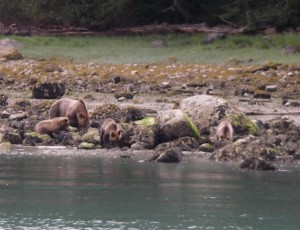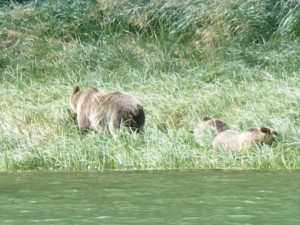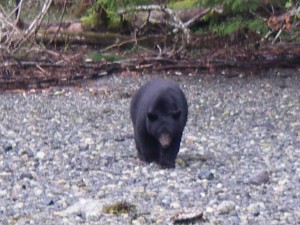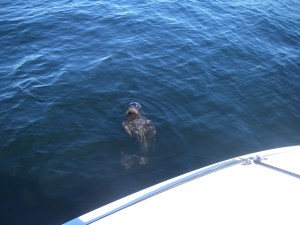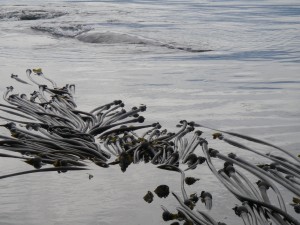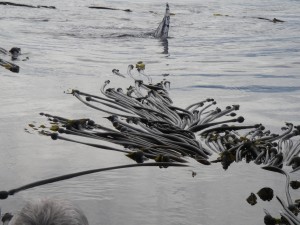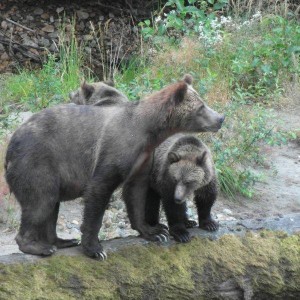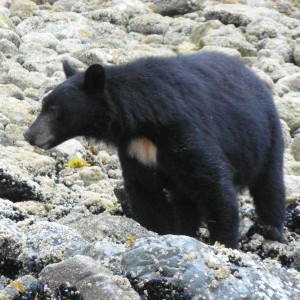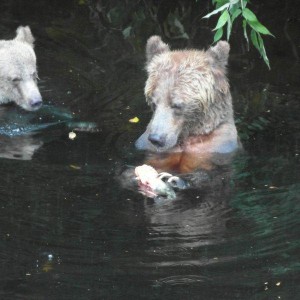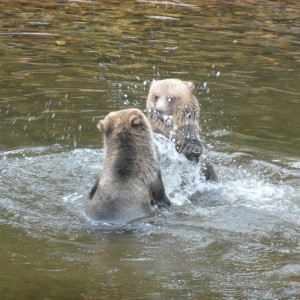Grizzly Bear and Wildlife Tour Blog
We offer an exceptional fly-in lodge for Grizzly Bear Watching and Whale Watching in British Columbia.
Learn about What’s happening at the Lodge, view our British Columbia’s Wildlife Report, read our Grizzly Bear Watching Blog and Whale Watching Blog. Learn more about a Day on the River Blog, see Our Tour Guide’s Photos & Blog and Photos from Our Guests.
Black bear ready for hibernation
Not the sharpest picture but it was taken in mid September to show a black bear with enough fat to hibernate. This bear is big enough to challenge a sub-adult grizzly. Several years ago there was a large black bear that did just that for the first part of the viewing season in the Glendale River estuary, the main area for observing grizzly. The first part of the season is mostly mothers with new and one year old cubs and some three and four year old grizzlies. The black bear mentioned managed to claim its part of the beach until one of the breeding male grizzly appeared and that was the last we saw of the black bear. It is interesting to note that the bear in this picture does not have access to the salmon rivers because of the grizzlies so its bulk is from grass, beach protein and berries. Once the berries appear in June they last through the fall. There are a variety of berries including; huckleberry, salmonberry, blackberry, salal berry, thimbleberry, and elderberry all within a short walk from the lodge.
Killer whales (orca) passing astern
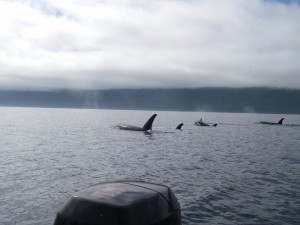
The overcast day may not seem too appealing unless you think about taking pictures from a boat. On bright days it is necessary to have the sun at your back or the reflection off the water will make picture taking difficult if not impossible. Marine mammals often change their direction of travel without notice and do not always cooperate in getting the boat in the right position. On a dull day their cooperation is not necessary. Again the motor in the picture is to provide an indication of the nearness of the orca pod.
Lunch visitor – Harbour seal
Not quite as dramatic or exciting as the previous post and the humpback whale visiting but still unique. Another day and a picnic with a visit from a harbour seal. This is the only time I have had a seal intentionally come this close. Harbour seals by nature are very timid and shy away from boats. However this one appears small and therefore young and may have not learned to fear boats. The advantage of sitting quietly and having lunch in an area with allot of marine wildlife.
Lunch visitor – Humpback
Click either photo to enlarge then click again
Picnic lunches on the whale watching tour can be interesting. I normally take a bathroom break around eleven of eleven-thirty in Telegraph Cove on Vancouver Island. Guests have time to have a coffee or hot chocolate and walk the boardwalk to visit the shops or museum. The stay is as long as you wish to make it, as we are not on a tight schedule unless it is your last day and then we need to be back at the lodge for the plane by three o’clock. Lunch is back on the water and this day it was at Bold Head in Blackfish Sound. We had tied to a kelp bed and were watching the whales in the distance when we had a visitor. As the pictures show a humpback came into the kelp to roll and play close to the boat (maybe twenty feet – eight meters) off the bow. I took the picture with a guest’s head in the shot to give perspective as to the distance. The whale stayed close for at least twenty minutes until another boat came into the area. It was a memorable experience.
Grizzly Bear Twins
The coat of a grizzly bear can be from a light cream colour to a dark brown or almost black. In this case it appears almost grey with a reddish brown tinge. This colouring seems to have been passed on to the cubs. It is not uncommon to see sibling cubs with much different colouring as the females while often breed with different males so siblings may have different fathers. The grizzly’s claws come in a variety of colours including black and brown but are usually white or yellowish. As shown by this photo the front claws are longer than the back and can be up to five inches long. The longer claws are designed for digging, as one of their favourite spring foods is the skunk cabbage roots or bulbs. The long front claws also allow the grizzly to catch and hold a salmon while it is being eaten. The pink salmon are covered with an over-abundance of disease-preventing slime which make them very hard for a human to hold but the bears seem to have no problem retaining this fish. Thanks to James and Wendy from Australia for the excellent photo.
Grizzly Bear Triplets
